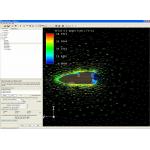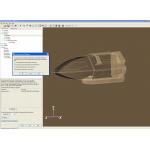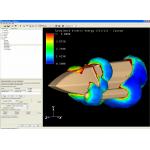Latest News
June 1, 2006
By Pamela J. Waterman
With computational fluid dynamics (CFD) becoming more the rule than the exception, a wider range of users is looking to take advantage of its capabilities early in the design process. To both simplify and speed up the process, Fluent developed FloWizard, a compact, designer-level version of its highly capable namesake software first offered in late 2004. The latest revision supports studies of compressible fluids, natural convection, heat-exchanger modeling, rotating machinery, and multiple customization possibilities, packing some pretty sophisticated analysis power for non-CFD experts.
FloWizard runs on both 32-bit and 64-bit Windows XP, and can be leased with Fluent’s RSolve (Remote Simulation Facility) service. Users will find the “next/back” step-through process very easy to follow, and at most stages, can click on “guide me” buttons to clarify choosing appropriate values and conditions. Version 2.1 now expands its “wizard” functions across geometry input, modeling tasks, boundary conditions, material properties, solver capabilities, and postprocessing options.
Walking through several of the six tutorials shipped with the software gives users an excellent feel for a typical analysis run. I reviewed the manifold, cyclone, sedan, and porous pipe files (there are also examples of nozzle and trumpet valve analyses), and in all cases, the first step involves setting the desired system of units and importing the CAD geometry. FloWizard now offers direct CAD connectivity through Pro/Engineer, SolidWorks, and UGS NX, as well as support for CATIA V5, Parasolid, ACIS, IGES, and other formats. You can also import an already meshed model (e.g., Nastran, Patran, HyperMesh) or work from geometries that only contain faces, no volumes.
 |
| FloWizard from Flutent. |
› › In FloWizard’s Results section, users can choose from dozens of parameters and display methods. Here, velocity magnitude vectors are shown on a Y,Z plane cut. Results can be animated to show the changes in velocity as the plane cut is swept along the Z axis.
You have the option at this point to check, repair, or smooth the geometry, or hold that decision for later. FloWizard takes advantage of model symmetry, if it exists, by letting you define a plane of symmetry, slice the model, and subsequently take half the processing time by operating on just half the data. You also indicate whether the imported geometry represents the solid model or the flow region around a model.
A great timesaver is the ability of the software to automatically create a flow region (internal or external) based on a few simple clicks defining the portions of the model to interface with the flow. You create inlets, outlets, and walls, then define the flow region, including its size as a scale of the model’s geometry. More prompts guide you through choosing compressible or incompressible fluids, continuous flow, multiple disconnected regions, multiple (possibly porous) regions, or just leaving it “unknown.”
With the overall model geometry completed, the next few steps walk you through the problem’s physical characteristics. You choose whether temperature considerations are important, if the flow is laminar, turbulent, turbulent with strong swirling, or unknown, and what properties define the fluid regions. FloWizard lets you work with air, water, or dozens of fluid choices with user-defined viscosity. If heat transfer is involved, a window opens prompting your input for the material of the solid, offering a choice of properties or the chance to define your own.
Defining the boundary conditions for the inlets, outlets, and walls is particularly simple due to the ability to group boundaries that share the same conditions. Dialog boxes prompt entries of values like velocity, flow rate, pressure, and direction of flow until each group is fully defined (indicated by green check-marks in the FloWizard status window). A View Summary of Inputs button lets you review all your choices for specifications, properties, and region definitions a last time before advancing to the solution stage.Solution Options
Sometimes you just want a quick indicator that your design is headed in the right direction; other times, you’re looking for more detailed operational parameters. Either way, FloWizard gives you the opportunity to optimize the analysis for speed, accuracy, or a midway approach via an easy slider-bar. You also have meshing options: optimize near or away from the walls and in simple geometries and small gaps, or create a mesh with uniform cell size either automatically or user-defined. The opportunity to apply geometry clean-up techniques forms the last step before moving into the actual solution phase.
› › FloWizard guides the user in deciding whether the flow is laminar, turbulent, or turbulent with a strong swirl. I wanted to view external flow, looking at first-order turbulence issues upon atmospheric reentry.
At this point, you can choose to just mesh the problem, with the option to send the file into Fluent 6, or to perform both the mesh and the full solution, without a Navier Stokes equation in sight. You also decide where the calculation should run: locally or, for users who have opted for the RSolve service, at Fluent’s remote facility. For the latter, a click on the dropdown menu automatically zips and sends the model directly to the corporate servers (no separate ftp or upload function is needed).
With either method, you are prompted to enter an acceptable limit to CPU-hours runtime, which can be useful if you’re interested in monitoring solution convergence time. Using RSolve offers an excellent way to free up your own computing resources, and you pay per CPU-hour in 15-minute increments. With either the local or remote approach, a Progress box opens whereby you can track the status of both the meshing and calculation stages.
FloWizard automatically creates a Results Summary file that includes tables of all the input and output values, mesh details, and solver information. In addition, it allows users to view, interrogate, save, and share visual computational results with simple clicks and choices. The main graphics window displays such values as static pressure, total pressure, velocity, turbulence kinetic energy, and turbulence dissipation rate (on your choice of boundary), and lets you define probe points with a click or by entering coordinate values.
Zoom, rotate, slice, and animate options offer infinite viewing possibilities. Version 2.1 improvements also allow users to look at velocity anywhere inside the fluid region, not just on walls, and to create isosurfaces for pertinent physical attributes.
At any point in viewing the results, you can click on Include This Picture in Final Report to save the image, along with a caption, in the Results Summary. Later, you have the option to rename, reorder, delete and add images, and add notes to each page. The report can also be zipped and e-mailed from within FloWizard, and viewed by recipients in Excel or HTML format.
I ran a Star Trek shuttlecraft model through FloWizard to view external flow behavior, looking at first-order turbulence issues upon atmospheric reentry. After reworking the model in SolidWorks to eliminate extraneous grills on the booster propulsion pods, I took advantage of symmetry and imported just half the shuttlecraft profile as a Parasolid file.
As a non-CFD expert, I appreciated all the checks, balances, “Guide Me” options, and Help windows throughout the analysis run; almost all my questions were neatly answered, and the ones that weren’t could be routed to Technical Support. I also tested the RSolve service and was very pleased with the automatic e-mail updates and the speed of the entire process as I tried both the remote meshing and computation functions.
› › Here, isosurface of turbulent kinetic energy are impinging on the shuttlecraft hull. The scale can be customized according to color and value by the user in the Results Display Options window of FloWizard.
A few minor thoughts: In the Preview of Flow region window, I would have liked to have seen not only the flow volume, but the actual boundary condition symbols with vector directions to help verify my decisions (once set, you can’t change these particular parameters). However, I liked the Summary of Inputs report that you can view prior to actually starting the calculations, as this does allow for other changes. Once the computations were complete, I appreciated the thoroughness of the results-viewing options, especially the point-probe values and flow pathlines.
I had wanted to use Mach level speeds when setting my input values. I ended up opting for a much lower speed, as the former would have been tricky to set up in the current version, though a simpler, far-field boundary approach is coming in FloWizard V2.2 in Fall 2006. It would also be nice if selected model edges remain highlighted once chosen, to clarify where you are in the process of creating boundaries. Lastly, the “estimated time to completion” clock changed so often it wasn’t very helpful, while it would be useful to have a clock that showed actual elapsed time.
It will be interesting to see how Fluent’s acquisition by ANSYS influences its technical and business structures. One effect already apparent may be the new pricing models announced in May: a Perpetual License, including 330 CPU-hours of solver time, and a three-seat Process Improvement and Implementation Package will cost in the neighborhood of $24,000.
It would also be enlightening to compare FloWizard and Fluent results. With simplified, or as some would say, “black box” analysis software, there are always some limitations: for example, FloWizard deals strictly with single-phase and steady-state fluid flow. But by contrast, a full-up CFD package would also run you $30,000 to $60,000, an expense that isn’t always warranted for the occasional user. All in all, FloWizard offers a well loaded, low-risk design evaluation package for non-CFD experts.
Contributing Editor Pamela J. Waterman is an electrical engineer and freelance technical writer based in Arizona. Send your comments about this article through e-mail by clicking here. Please reference “FloWizard, July 2006” in your message.
Product Information
FloWizard 2.1
Fluent, Inc.
Requirements
Windows XP with 512 MB RAM
Starting Prices
FloWizard/RSolve license: $7,000 annual
Perpetual FloWizard/RSolve license: $17,000
Current Fluent owners: $5,000
(Note: Exact prices for each version vary depending on number of seats and CPU-hours purchased.)
Subscribe to our FREE magazine, FREE email newsletters or both!
Latest News
About the Author
Pamela Waterman worked as Digital Engineering’s contributing editor for two decades. Contact her via .(JavaScript must be enabled to view this email address).
Follow DE





